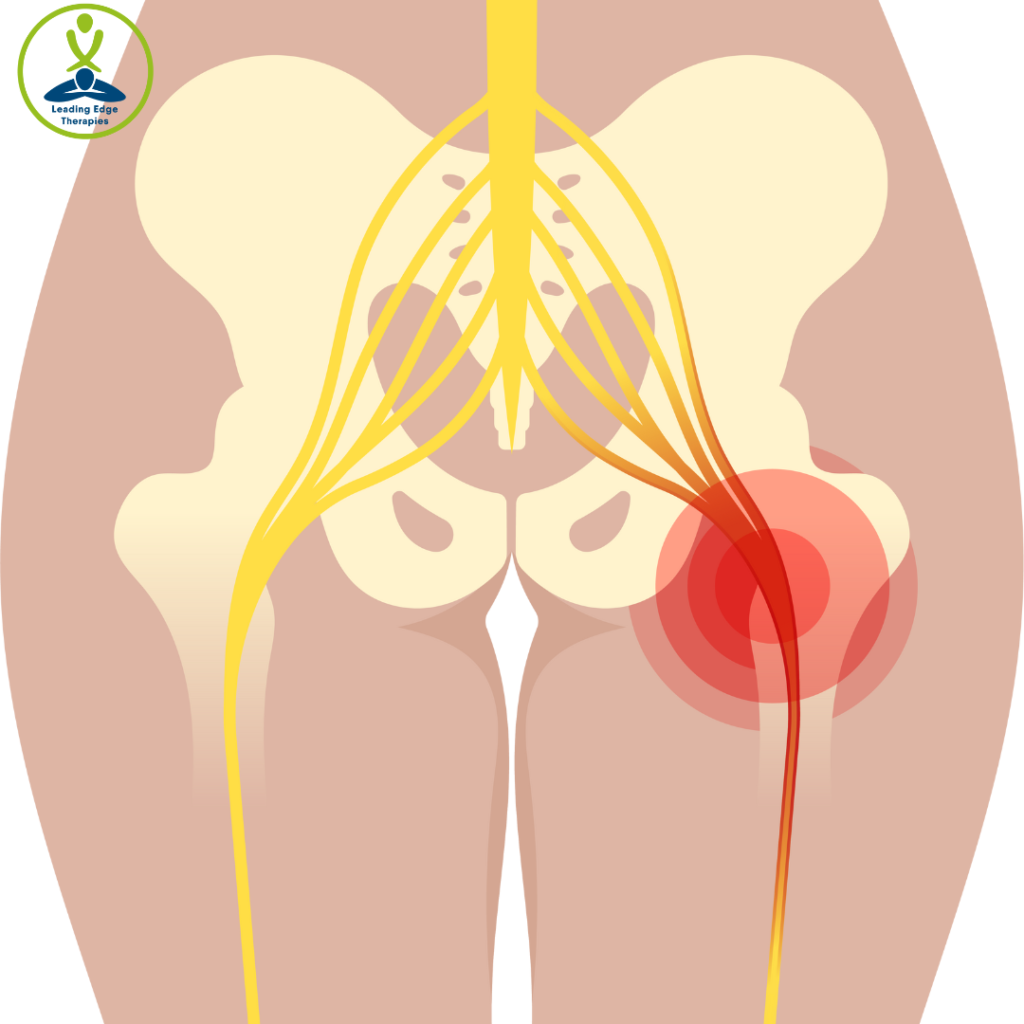Sciatica refers to pain that radiates along the path of the sciatic nerve, which extends from your lower back through the hips and buttocks and down each leg. Typically, sciatica affects only one side of the body. It most commonly occurs when a herniated disk, bone spur on the spine, or narrowing of the spine (spinal stenosis) compresses part of the nerve. This causes inflammation, pain, and often some numbness in the affected leg.
Anatomy of the Sciatic Nerve
The sciatic nerve is the longest and thickest nerve in the human body. It originates from the lower lumbar (L4-L5) and sacral (S1-S3) regions of the spine, combining to form the sciatic nerve that runs through the buttocks and down the back of the thigh, branching into smaller nerves that continue to the feet and toes.

Common Causes of Sciatica
- Herniated Disk: A bulging or slipped disk in the lower spine can press on the sciatic nerve, causing sharp pain.
- Spinal Stenosis: Narrowing of the spinal canal can compress the sciatic nerve.
- Piriformis Syndrome: The piriformis muscle, located in the buttock region, can irritate the sciatic nerve if it becomes tight or spasms, leading to sciatica.
- Degenerative Disc Disease: Wear and tear on the spinal discs can result in bone spurs or inflammation, irritating the sciatic nerve.
Symptoms of Sciatica
- Sharp pain that travels from the lower back down to the legs.
- Numbness or tingling in the affected leg.
- Weakness in the affected leg or foot.
- Shooting pain that worsens with movements like standing or sitting.
How Clinical Massage Therapy Can Help
Massage therapy for sciatica involves techniques that aim to alleviate the pressure on the sciatic nerve, reduce muscle tension, improve circulation, and restore mobility. Here’s a detailed look at how massage can help with sciatica:
1. Release of Muscle Tension
One of the most common causes of sciatic pain is the tightness of muscles like the piriformis and gluteal muscles. The piriformis muscle, in particular, can directly compress the sciatic nerve if it becomes tight or spasms (piriformis syndrome). Massage therapy can help to loosen these muscles, relieving tension and reducing pressure on the nerve.

2. Improved Circulation and Tissue Healing
Massage therapy increases blood flow to the affected area, promoting healing by bringing oxygen and nutrients to the injured tissues. This also helps reduce inflammation and swelling around the sciatic nerve.
3. Myofascial Release
Myofascial release techniques target the fascia, the connective tissue that surrounds muscles. By loosening the fascia, massage therapists can relieve restrictions in the tissues around the sciatic nerve, helping alleviate pain and restore mobility.
4. Trigger Point Therapy
Trigger points, or “knots,” can form in muscles that are under strain due to poor posture, injury, or overuse. These knots can radiate pain to other areas, including the lower back and legs. Clinical massage techniques that focus on releasing these trigger points can reduce sciatic pain by decreasing muscular tension and referred pain.
5. Reduced Stress on the Spine
Massage can also help align the spine by relaxing the muscles that pull on it unevenly. Misalignment can exacerbate conditions like herniated discs, which may press on the sciatic nerve. By relaxing the supporting muscles, massage may allow for better spinal alignment and reduced pressure on the nerve roots.
Types of Massage Techniques for Sciatica
- Deep Tissue Massage: Targets the deeper layers of muscle and connective tissue. It’s especially effective in releasing chronic muscle tension, which can compress the sciatic nerve.
- Neuromuscular Massage: This form of massage specifically focuses on trigger points and muscle tension that may be affecting the sciatic nerve.
- Myofascial Release: This gentle technique targets the fascia and can help release tension around the lower back, hips, and buttocks.
- Swedish Massage: While this is a lighter form of massage, it can still help relieve tension and promote circulation, assisting in overall muscle relaxation and pain reduction.
- Hot Stone Massage: The heat from stones can help loosen tight muscles, making it easier to release tension and reduce pressure on the sciatic nerve.
Evidence Supporting Massage Therapy for Sciatica
Several studies have supported the use of massage therapy for sciatica. For instance, a 2014 study published in the journal Pain Medicine found that deep tissue massage significantly reduced pain and improved function in patients with chronic sciatica. Another study published in Clinical Rehabilitation highlighted that myofascial release techniques improved flexibility and reduced pain in patients with lower back pain and sciatica symptoms.
Moreover, the American Massage Therapy Association (AMTA) recognizes the use of massage therapy for managing conditions like sciatica. Combining massage with stretching and strengthening exercises has also been shown to improve outcomes in those suffering from sciatic pain.
When to Avoid Massage for Sciatica
While massage is generally safe and effective for many sciatica sufferers, there are some conditions where it may not be appropriate:
- Acute injury or recent trauma to the spine.
- Severe disc herniation where nerve compression is significant and surgical intervention is recommended.
- Infections or inflammation of the spinal region.
- Deep vein thrombosis (DVT) in the legs, which can mimic symptoms of sciatica.
Conclusion
Massage therapy can be a highly effective treatment option for those suffering from sciatica. By addressing muscle tightness, improving circulation, and relieving pressure on the sciatic nerve, clinical massage therapy helps reduce pain, improve function, and promote healing. It’s essential to work with a trained massage therapist who can assess your specific condition and tailor the treatment accordingly.
Always consult with a healthcare provider before beginning massage therapy, especially if your sciatica symptoms are severe or related to structural problems in the spine. Combining massage with exercise, physical therapy, and proper ergonomics can offer comprehensive relief from sciatica.
References
https://www.amtamassage.org/publications/massage-today/massage-sciatic-nerve-pain
https://www.dorsalhealth.com/blog/sciatica-massage-pain-benefits





